Selected Publications
2025
ArXiv
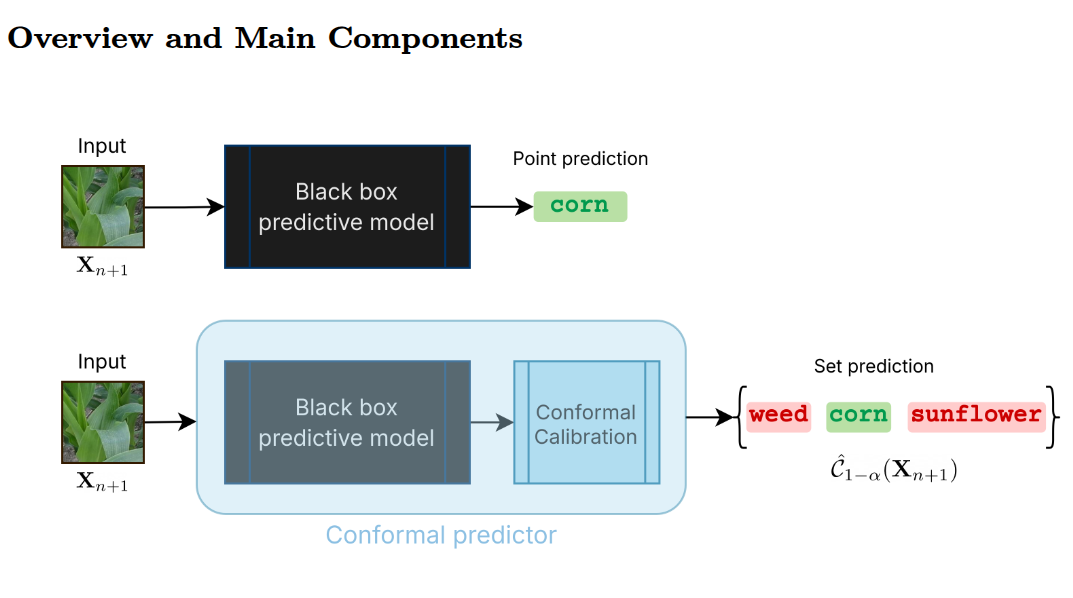
Uncertainty Guarantees on Automated Precision Weeding using Conformal Prediction
Melki, P., Bombrun, L., Diallo Boubacar, Dias, J., & Da Costa, J. P.
arXiv preprint arXiv:2501.07185, 2025. [Paper]
Melki, P., Bombrun, L., Diallo Boubacar, Dias, J., & Da Costa, J. P.
arXiv preprint arXiv:2501.07185, 2025. [Paper]
After a detailed presentation of the conformal prediction methodology and the development of a precision spraying pipeline
based on a ''conformalized'' neural network and well-defined spraying decision rules, the article evaluates this pipeline
on two real-world scenarios: one under in-distribution conditions, the other reflecting a near out-of-distribution setting.
2024
CVPR
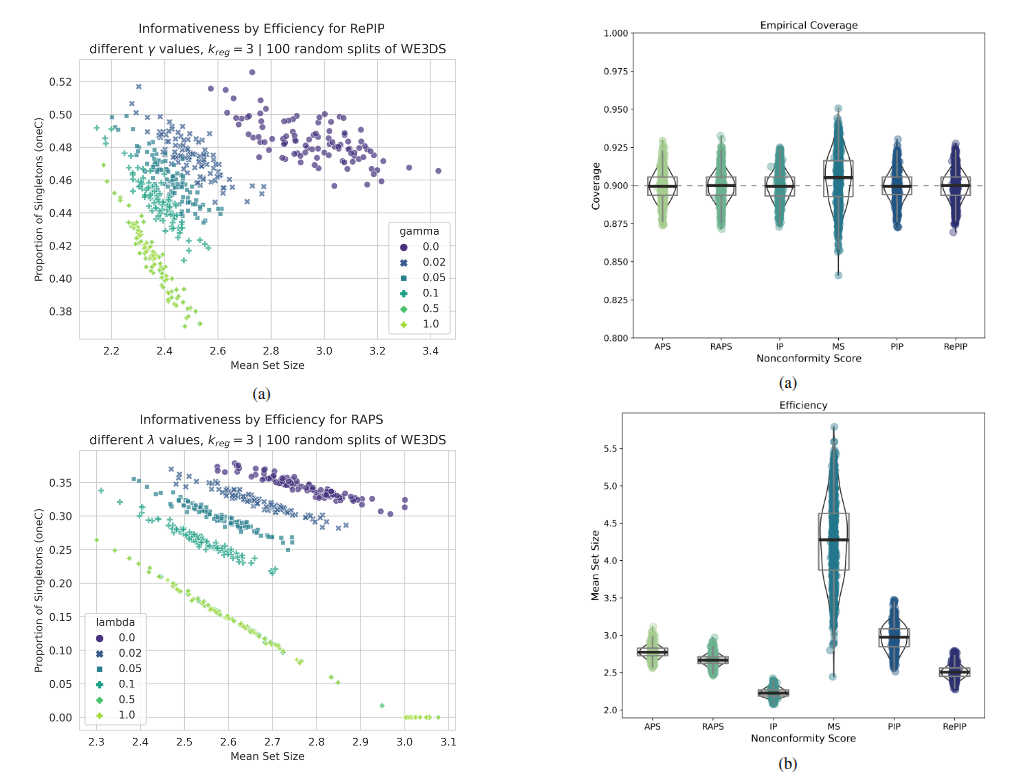
The Penalized Inverse Probability Measure for Conformal Classification
Melki, P., Bombrun, L., Diallo Boubacar, Dias, J., & Da Costa, J. P.
In Proceedings of the Conference on Computer Vision and Pattern Recognition (CVPR), 2024. [Paper]
Melki, P., Bombrun, L., Diallo Boubacar, Dias, J., & Da Costa, J. P.
In Proceedings of the Conference on Computer Vision and Pattern Recognition (CVPR), 2024. [Paper]
Through toy examples and empirical results on the task of crop and weed image classification in agricultural robotics,
the current work shows how PIP-based conformal classifiers exhibit precisely the desired behavior in comparison with
other nonconformity measures and strike a good balance between informativeness and efficiency.
ArXiv
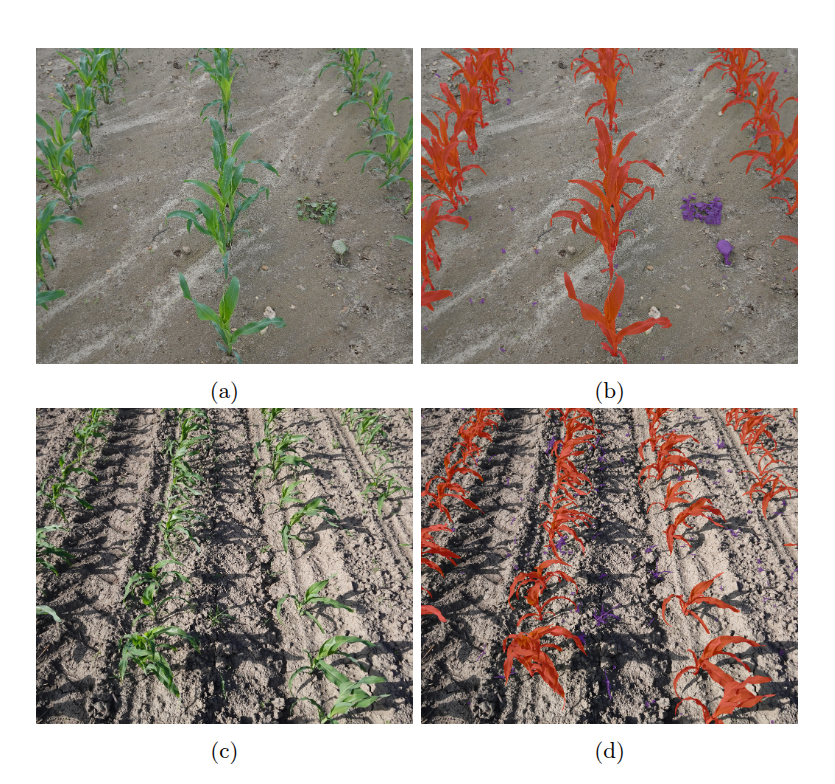
Active learning for efficient annotation in precision agriculture: A use-case on crop-weed semantic segmentation.
van Marrewijk, B. M., Dandjinou, C., Rustia, D. J. A., Gonzalez, N. F., Diallo Boubacar & Blok, P. M..
(ICCV 2023) - ArXiv preprint arXiv:2404.02580, 2024. [Paper]
van Marrewijk, B. M., Dandjinou, C., Rustia, D. J. A., Gonzalez, N. F., Diallo Boubacar & Blok, P. M..
(ICCV 2023) - ArXiv preprint arXiv:2404.02580, 2024. [Paper]
This study addresses this research gap by conducting a comparative study of three active learning-based acquisition functions:
Bayesian Active Learning by Disagreement (BALD), stochastic-based BALD (PowerBALD), and Random.
The acquisition functions were tested on two agricultural datasets: Sugarbeet and Corn-Weed, both containing
three semantic classes: background, crop and weed.
2023
AgriTech
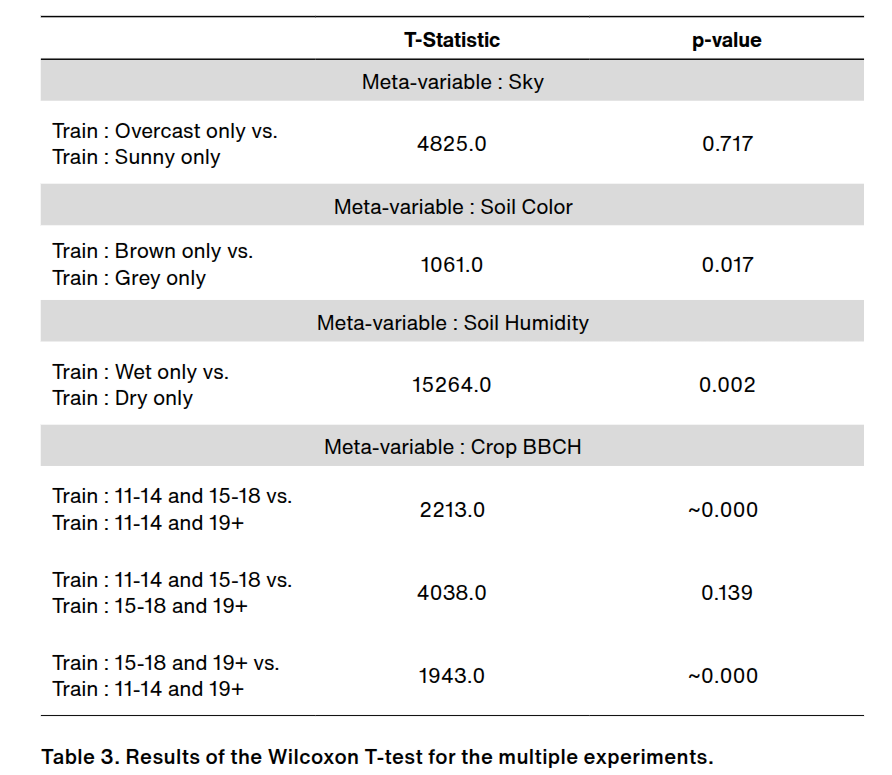
Impact of the Environmental Conditions on the Robustness of a Weed Detection Model
Nicolas Franco Gonzalez, Paul Melki, Boubacar Diallo, Hugo Antoine, Estelle Millet.
AgriTech Day (SIMA), 2023. [Paper]
Nicolas Franco Gonzalez, Paul Melki, Boubacar Diallo, Hugo Antoine, Estelle Millet.
AgriTech Day (SIMA), 2023. [Paper]
The main contribution of this article is the proposal of a methodology for analyzing the impact of this variability
on weed detection quality. We focus only on four intrinsic and external factors that contribute to the variability
of conditions (which we call meta-variables) : the vegetation development stage (using the BBCH scale), the soil
characteristics, namely its color and humidity level, and the condition of the sky at the moment of image acquisition (sunny or overcast).
ICCV
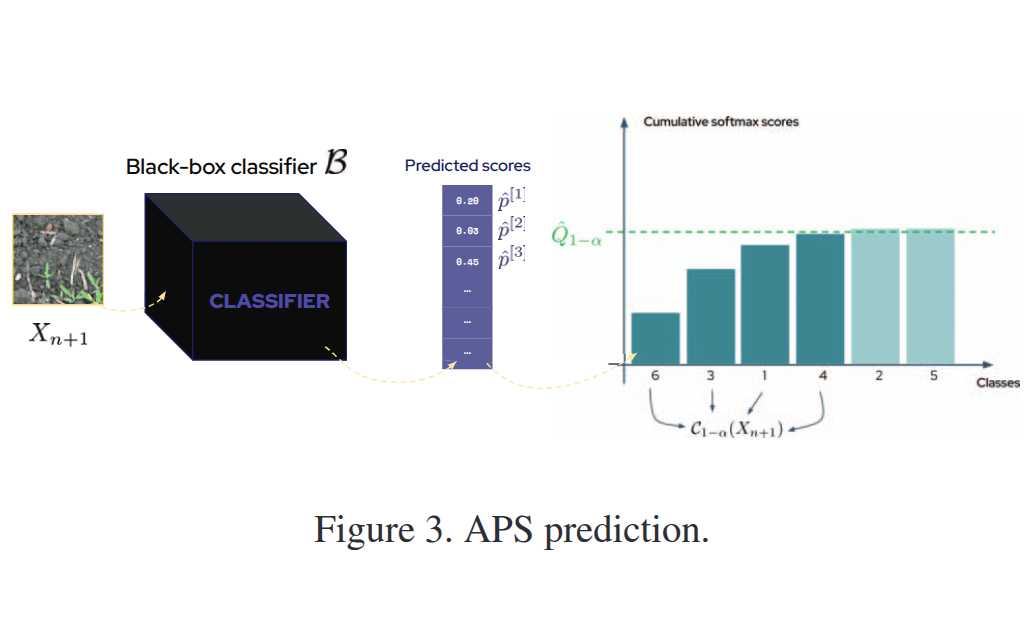
Group-Conditional Conformal Prediction via Quantile Regression Calibration for Crop and Weed Classification
Paul Melki, Lionel Bombrun, Boubacar Diallo, Jérôme Dias, Jean-Pierre Da Costa
Proceedings of the IEEE/CVF International Conference on Computer Vision (ICCV), 2023. [Paper]
Paul Melki, Lionel Bombrun, Boubacar Diallo, Jérôme Dias, Jean-Pierre Da Costa
Proceedings of the IEEE/CVF International Conference on Computer Vision (ICCV), 2023. [Paper]
This article presents the conformal prediction framework that provides valid statistical guarantees on
the predictive performance of any black box prediction machine, with almost no assumptions,
applied to the problem of deep visual classification of weeds and crops in real-world conditions.
ICCV Poster

Active learning for efficient annotation in crop-weed semantic segmentation.
Blok, P. M., van Marrewijk, B. M., Boubacar Diallo, Dandjinou, C., Gonzalez, N. F., Melki, P., ... & Dias, J.
Proceedings of the IEEE/CVF International Conference on Computer Vision (ICCV), 2023. [Paper]
Blok, P. M., van Marrewijk, B. M., Boubacar Diallo, Dandjinou, C., Gonzalez, N. F., Melki, P., ... & Dias, J.
Proceedings of the IEEE/CVF International Conference on Computer Vision (ICCV), 2023. [Paper]
In agriculture, datasets tend to contain more redundant images and imbalanced classes.
Therefore, in this research the added value of active learning was tested on a Corn-Weed dataset.
Three acquisition functions were compared: BALD, PowerBALD and Random.
Both BALD and PowerBALD outperformed Random sampling even when 90.9% of the pixels belonged to the background class.
2022
CEA: Elsevier
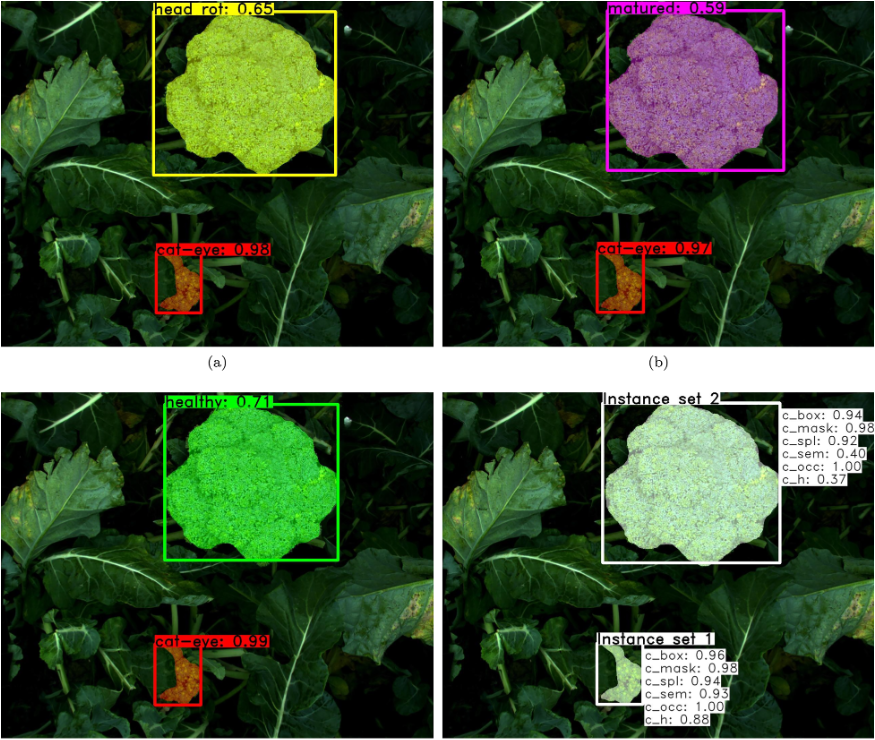
Active learning with MaskAL reduces annotation effort for training Mask R-CNN on a broccoli dataset with visually similar classes
Pieter M Blok, Gert Kootstra, Hakim Elchaoui Elghor, Boubacar Diallo, Frits K van Evert, E. van Henten.
Computers and Electronics in Agriculture, Elsevier (CEA: Elsevier), 2022. [Paper]
Pieter M Blok, Gert Kootstra, Hakim Elchaoui Elghor, Boubacar Diallo, Frits K van Evert, E. van Henten.
Computers and Electronics in Agriculture, Elsevier (CEA: Elsevier), 2022. [Paper]
The goal of our work was to reduce the number of annotated images needed to train a CNN while maintaining its performance.
We use an active learning method capable of automatically selecting difficult-to-classify images and based on the Mask R-CNN
instance segmentation algorithm and named this method MaskAL.
GRETSI
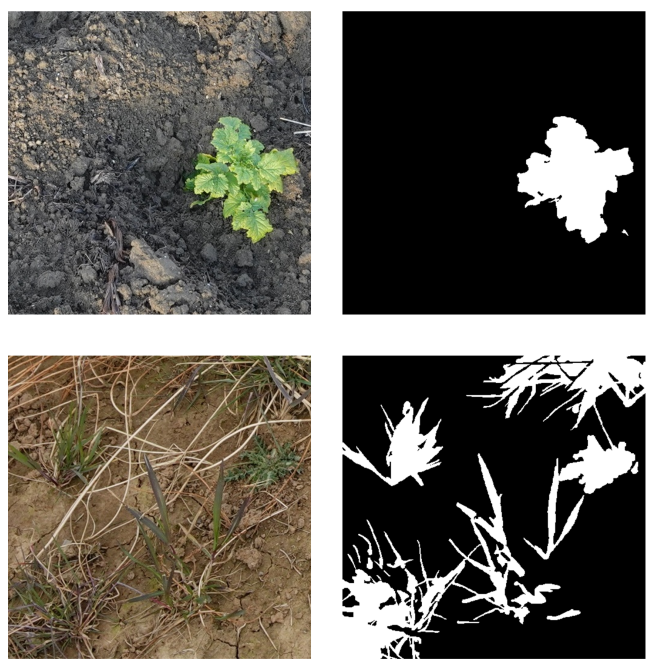
Analyse exploratoire de métriques en segmentation d'images: application en proxidétection
Melki, P., Bombrun, L., Millet, E., Boubacar Diallo, Elghor, H. E., & da Costa, J. P.
In Groupe d'Etudes du Traitement du Signal et des Images (GRETSI), 2022. [Paper]
Melki, P., Bombrun, L., Millet, E., Boubacar Diallo, Elghor, H. E., & da Costa, J. P.
In Groupe d'Etudes du Traitement du Signal et des Images (GRETSI), 2022. [Paper]
Working in an agricultural context, specifically on the problem of the automatic detection of plants in proximal
sensing images, we studied twelve evaluation metrics that we used to evaluate three image segmentation models
recently presented in the literature. After a unified presentation of these metrics, we carried out an exploratory
analysis of their relationships using a correlation analysis, a clustering of variables, and two factorial analyses
(namely principal component analysis and multiple factorial analysis). .
2020
Ph.D Report
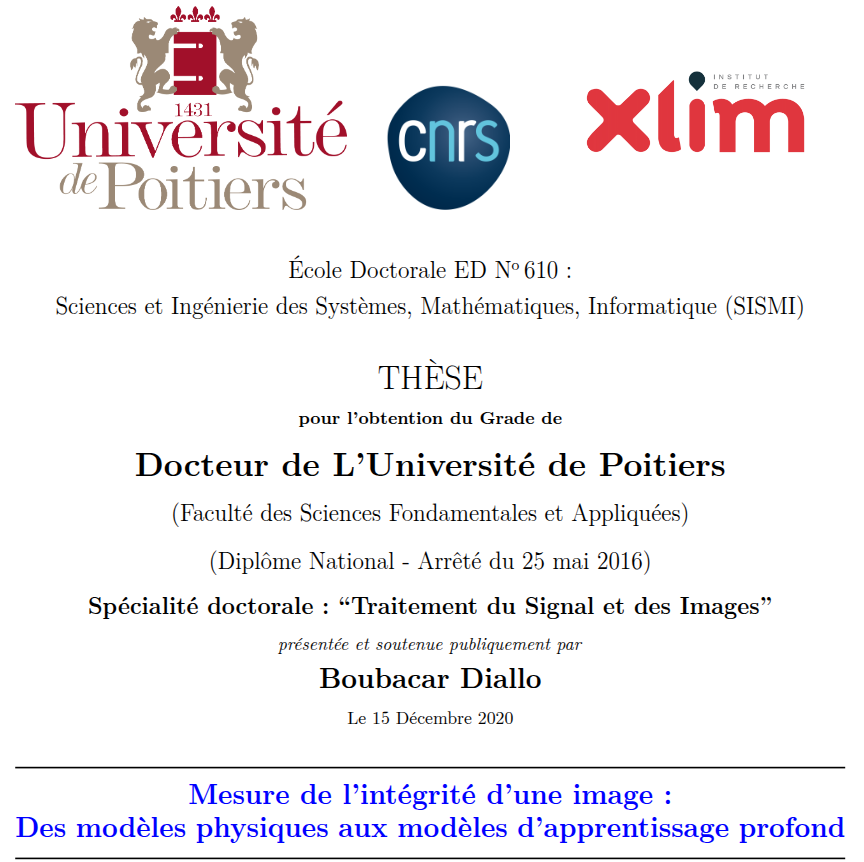
Mesure de l'intégrité d'une image : des modèles physiques aux modèles d'apprentissage profond
Boubacar Diallo, HAL science ouverte, December 2020. [Paper]
Boubacar Diallo, HAL science ouverte, December 2020. [Paper]
In this thesis, we focus on several of these image forensic challenges including camera
model identification and image tampering detection. After reviewing the state of the
art in the field, we propose a first data-driven method for identifying camera models.
We use deep learning techniques based on convolutional neural networks (CNNs)
and develop a learning strategy considering the quality of the input data versus the
applied transformation. A family of CNN networks has been designed to learn the
characteristics of the camera model directly from a collection of images undergoing
the same transformations as those commonly used on the Internet.
FSI
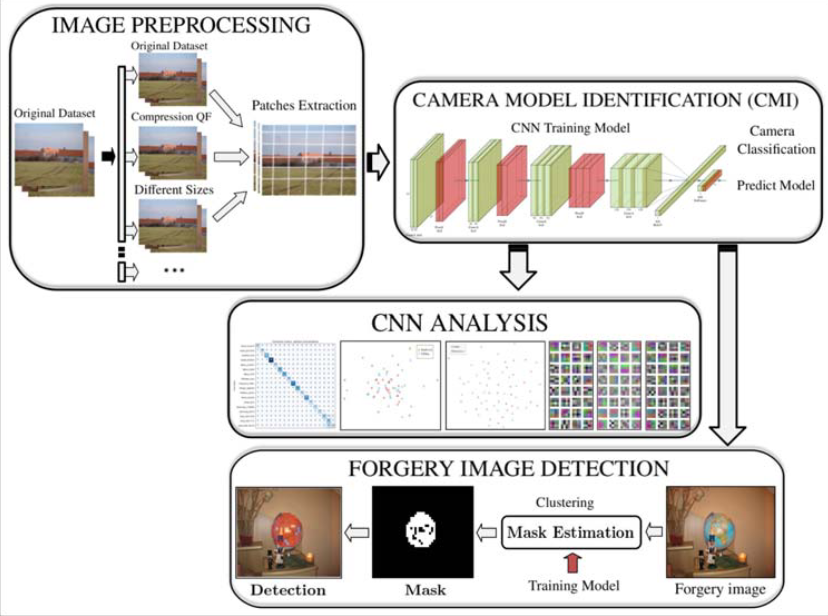
Robust forgery detection for compressed images using CNN supervision
Boubacar Diallo, Thierry Urruty, Pascal Bourdon, Christine Fernandez-Maloigne.
Forensic Science International: Reports (FSI: Reports), 2020. [Paper]
Boubacar Diallo, Thierry Urruty, Pascal Bourdon, Christine Fernandez-Maloigne.
Forensic Science International: Reports (FSI: Reports), 2020. [Paper]
This article presents a framework improving robustness for image forgery detection.
The most important step of our framework is to take into account the image quality corresponding
to the chosen application. Therefore, we relied on a camera identification model based on convolutional
neural networks.
2019
MMM
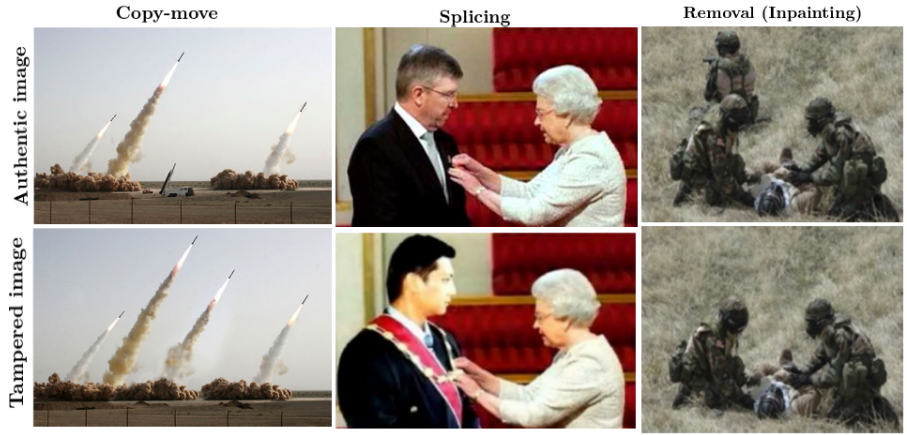
Improving robustness of image tampering detection for compression
Boubacar Diallo, Thierry Urruty, Pascal Bourdon, Christine Fernandez-Maloigne.
MultiMedia Modeling: 25th International Conference (MMM), 2019. [Paper]
Boubacar Diallo, Thierry Urruty, Pascal Bourdon, Christine Fernandez-Maloigne.
MultiMedia Modeling: 25th International Conference (MMM), 2019. [Paper]
Improving the robustness of tampered image detection algorithms is essential for compression manipulation
as it is the most common type of post-processing on the Internet.